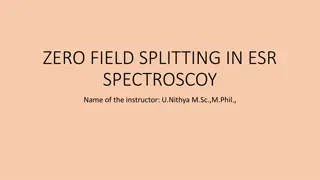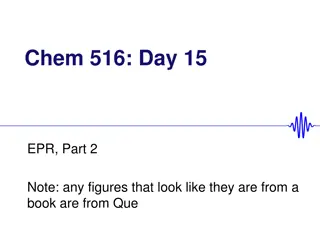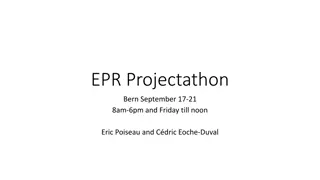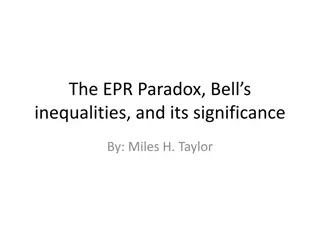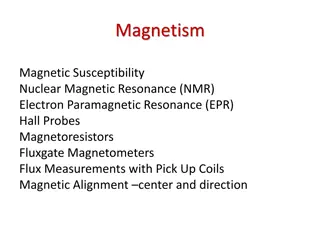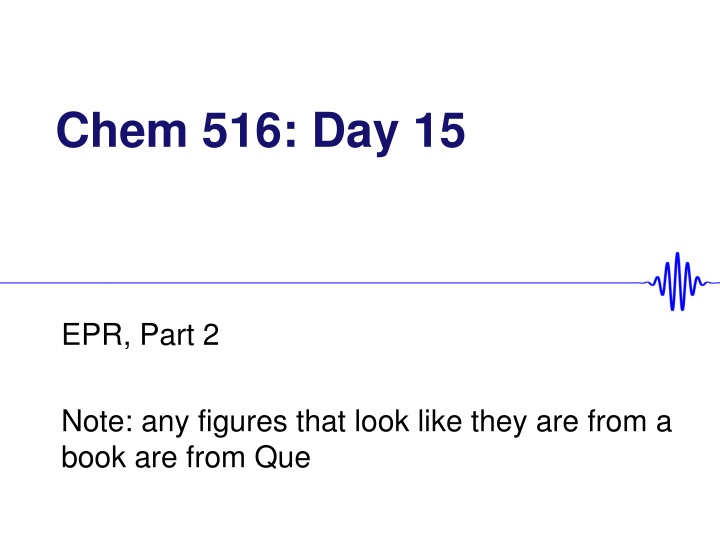
EPR Spectroscopy and Molecular Symmetry
Explore the application of EPR spectroscopy in examining molecular symmetry, electronic structure, and nuclear spins coupling with unpaired electrons. Understand the significance of anisotropy, spin-orbit coupling, and deviations in g-factor values. Dive into insightful discussions on electron movements in different geometries and their effects on EPR signals.
Download Presentation

Please find below an Image/Link to download the presentation.
The content on the website is provided AS IS for your information and personal use only. It may not be sold, licensed, or shared on other websites without obtaining consent from the author. If you encounter any issues during the download, it is possible that the publisher has removed the file from their server.
You are allowed to download the files provided on this website for personal or commercial use, subject to the condition that they are used lawfully. All files are the property of their respective owners.
The content on the website is provided AS IS for your information and personal use only. It may not be sold, licensed, or shared on other websites without obtaining consent from the author.
E N D
Presentation Transcript
Chem 516: Day 15 EPR, Part 2 Note: any figures that look like they are from a book are from Que
Groups for Think-Pair-Share Beckley, Aidan T Bender, Noah A Lastowski, Robert J Medina Nales, Kevin Boedicker, Lauren V Chakrabarti, Sagnik Melari, Angelo J Schmit, Claire E Fatima, Saman Gray, Daniel W Wang, Jingxiang Wells, Brady Greskovich, Katherin Gullett, Kelly L Wo, Anita Zhang, Xueyong Heidari, Hirbod Hernandez Al, Erick Send your partner a chat! Holm, Annika R Hua, Qi Kelly, Kimberly A
What we saw last class for a single electron in an s orbital ms = 1/2 E E = g H ms = -1/2 H A H A H
So what good is this? For a free electron, g=2.0023 Deviation from 2.0023 is caused by spin-orbit coupling: which orbital is that unpaired electron in? Anisotropy (gx,gy,gz) gives molecular symmetry, more info on electronic structure Nuclear spins will couple to the electron spin, give hyperfine and superhyperfine coupling: which nuclei are near that unpaired electron?
Point 1: Anisotropy gz gx,gy
First question: why does this look backwards? g < g , but g is to the left of g : why? The x axis is H, and E=g H, therefore g= E/ H g and H are inversely proportional: H goes up, g dows down
But Josh, you still havent explained why g 2! Case 1: Mo(V) is 4d1, and can have several geometries 1) Compressed Octahedron 2) 8-coordinate ?2 ??,?? ?2 ?2 ?2 Rx, Ry ?? Rz ??,?? Rx, Ry Rz ?2 ?2 ?? g < g < 2 - Moving e- opposes the EPR magnet, so you need to crank up H more - Smaller energy gap: better circulation, so greater effect - g < g < 2 (remember gz=g )
If you are moving a hole, then the moving e- helps the magnet, so opposite effect NiI ?2 Rx, Ry ?2 ?2 ??,?? ?? Now ?2??,????,??, so g > 2. No rotation around z, so g = 2
This is quantitative!! ?2 ? = 2.0023 +? ? Rz, 2 ?? ?? ? is the number on the pentagon for that rotation is the spin-orbit coupling for that atom Example: CuII = -830 cm-1 Ry, 2 Ry, 2 ?2 ?2 ?? Rz, 8 CuII porphyrin, gz=2.70, gx,y=2.04 ?2 ?2 ??= 2.0023 +8 830?? 1 Rz ?2 ? Rx, Ry ??2 ?2,??= -9520 cm-1 = -1.1 eV ?? ??,?= 2.0023 +2 830?? 1 ? ??,?? ??2 ?2,??/??= -44,000 cm-1 = -5.4 eV
How the heck do they get those numbers? ??= ? ?? ?? ?? ?? ?+1= 1 15 2? ? + ?? ? ?2 2 1 2 15 2? ? ?? ? ?2 ? 1= ? + ??2 ?2 ?+2=1 15 2? 4 ? ??2 ?2 ? 2= 1 15 2? 4
Your final task for today: Suppose you measure the EPR of a Cu protein, and observe gx=2.155, gy=2.155, gz=2.0023. You suspect the Cu geometry is either an axially elongated octahedron or a trigonal bipyramid Axially elongated Oh Trigonal bipyramid Which does the EPR spectrum support?








